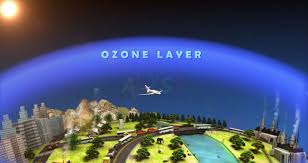Posted by
The Open Page |
17/09/2018

Introduction
The September 16 observance of International Day for the Preservation of the Ozone Layer becomes very significant.
Ozone is a chemical, a bluish gas, one molecule of which has three Oxygen atoms. The normal Oxygen molecule has only two atoms of Oxygen. Oxygen is naturally formed by the effect on Sun's ultraviolet rays falling on the atmospheric Oxygen. It is also formed by lightning. Almost all the atmospheric Ozone lies concentrated as a thin layer enveloping the Earth at a height of about twenty four to thirty kilometers high above ground. This is the Ozone Layer.
It is a necessity that there should be a Ozone Layer to in the atmosphere. This layer of Ozone filters the dangerous Ultra Violet rays emanating from the Sun, and prevents them in reaching the earth's surface. Ultraviolet rays cause blindness and skin cancer in humans and reduced crop output in agriculture. The Ozone layer also stabilizes the Oxygen cycle in the atmosphere.
However there are many man made industrial gases which reach up and reacting with Ozone destroy them. The major contributors to this ozone depletion are the group of chemicals called Chloro-Fluoro-Carbons (CFCs). These prime ozone depleters are Used as refrigerants and in aerosol sprays. One molecule of CFC can destroy one million molecules of Ozone.
Similarly, the industrial activities of man produce some amount of Ozone at lower level. This Ozone at lower level in human habitats and crops are dangerous to human life and plant life. Hence, the real concern is to stopping of these chemicals and getting rid of CFCs.
The Montreal Protocol decided to ban the CFC s and other ozone depleting chemicals. The UN declaration for International Day for the Preservation of the Ozone Layer, and the awareness programmes has positive effect. Though the production of CFCs and other depletion causing chemicals are banneed, the same already produced are still in the atmosphere and it will be more time till they get destroyed. The report of Montreal protocol study for 2010 states that the overall global zone and the polar ozone level are not decreasing, but not increasing also. The UV levels in mid latitudes almost remain at constant level in the concluded decade. The other study models done by scientists suggest that the Ozone level may not be reverting back to its pre-1980 level so soon. While they guess that the Antartic layer will recover by 2050 that at the tropics may need a century more, at the best positive estimates. The Ozone hole measured about 29.9 million square kilometers on September 29, 2000, but the mean ozone hole in 2010 was 22.2 million square kilometers.
In this situation the serious efforts towards Protection and preservation of Ozone Layer cannot be slackened.
Read Full Post »